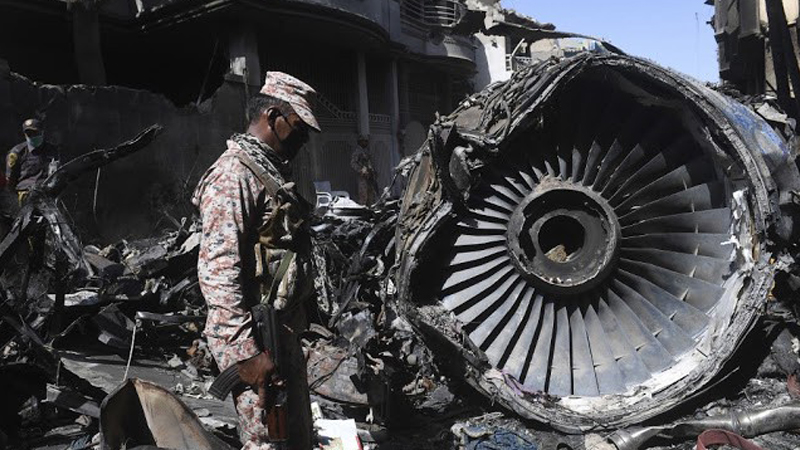The tragic crash of flight PK8303 in a residential area close to Karachi airport seemed to attract many attention seeking public personalities. Several prominent figures visited the crash site and made media appearances in the middle of rubble with their dozens of companions. These include politicians, philanthropists, social activists, civil and military bureaucracy and showbiz and sports celebrities. A majority of those who took all the pains to not only reach the crash site but also manage to get them photographed has only hindered the rescue and evidence-collection operations. This incident has exposed an inhuman trend of crisis tourism in our society.
 The trend which was arguably popularized by Shehbaz Sharif, the former chief minister of Punjab, has touched new heights lately. The Sindh governor and the federal aviation minister reached the disaster site accompanied by their supporters, staff and security and addressed a news conference boasting about the response of the government to the incident. Can these two prominent politicians explain in what ways their visit and media-talk helped disaster relief operation and why was their physical presence necessary at all? Another painful sight was to spot Shahid Afridi, the former captain and cricketing star in the middle of devastated street. Surrounded by the army men, he was apparently being briefed by those military officials who were taking part in rescue operation. Can Mr Afridi or those who were escorting him through the debris of the unlucky plane explain what was a former cricketer doing at the disaster site and why was he given protocol by those who were supposed to disallow any such publicity trick?
The trend which was arguably popularized by Shehbaz Sharif, the former chief minister of Punjab, has touched new heights lately. The Sindh governor and the federal aviation minister reached the disaster site accompanied by their supporters, staff and security and addressed a news conference boasting about the response of the government to the incident. Can these two prominent politicians explain in what ways their visit and media-talk helped disaster relief operation and why was their physical presence necessary at all? Another painful sight was to spot Shahid Afridi, the former captain and cricketing star in the middle of devastated street. Surrounded by the army men, he was apparently being briefed by those military officials who were taking part in rescue operation. Can Mr Afridi or those who were escorting him through the debris of the unlucky plane explain what was a former cricketer doing at the disaster site and why was he given protocol by those who were supposed to disallow any such publicity trick?
It is a very unpleasant scene that disasters are becoming new sites of “Public Relations Management” in our country. Electronic media and social media celebrities find in disasters a ready-made content for the day. Similarly, politicians compete for more air-time to win the sympathies of the public. Also, state departments which have a very serious role to play in such crises struggle to portray their relevance while working separately and distinctively. Meanwhile, evidence-collection and disaster relief operations are lost in this scuffle.
Electronic media and social media celebrities find in disasters a ready-made content for the day
Yet another dark side of our disaster management is self-proclaimed expertise seen in abundance on social and electronic media. Thanks to Google, people who do not have even a remote understanding of the issue suddenly become expert of unparalleled excellence to inform an already sensationalized public about causes and consequences of the disaster. All this happens long before the relief operation could take any shape or an investigation team could be constituted. This wave is so strong that heads of related institutions find it irresistible for them to address a news conference. As a result, significant amount of energy is lost in shaping, countering and propagating various crisis related narratives on social and electronic media. Such politicization of disasters is rarely seen in the civilized world.
Despite having a clear mandate and huge sums of money, disaster management authorities of federation and units have either failed to implement SOPs to deal with various kinds of disasters or are simply unable to draft any procedures. On ground situation is rather dismal. Coordination between various departments taking part in relief operation after any big crisis is rarely seen. Public, police, fire brigade, armed forces, non-governmental organizations and investigation agencies take part in rescue operation and investigations on their own without any predetermined coordination mechanism. As a result, rescue operation takes longer than necessary time and precious evidences are lost in the process. Moreover, those who lost their loved-ones and properties have to go through an additional pain of confusion and panic. Therefore, it is need of the hour to develop comprehensive SOPs to deal with disasters while establishing national and provincial disaster management authorities on more professional basis.
At the same time, it is a voluntary social responsibility of public and public servants alike to discourage any publicity stunts and crisis tourism. Media must also consider social, technical and legal sensitivities while delivering disaster related news. After all, it’s not TV and mobile screens but disaster sites that need focused and selfless attention of individuals and institutions. Disasters must not be taken as opportunity to gain from. Instead, they must be seen as events to learn from so that future injury can be averted.
The writer is a freelance contributor and can be reached at aamir9465@gmail.com